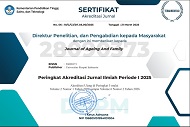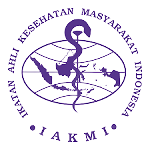Correlation Between The Nutrient Status And The Toddler Growth Of 3 And 4 Years Old In Rau Primary Health Center, Serang City In 2019
Abstract
Background: In the prevalence of Under-nutrition (Underweigth) the improvement occurred successively from 2013 amounted to 19.6%, up to 17.7% 2018. Despite the decline, the decline recorded was judged to be still insignificant. The World Health Organization (WHO) sets a prevalence limit of 20 percent for malnutrition. In fact, 'closing down' cases of malnutrition has been recorded as one of the targets of the Sustainable Development Goals (SDGs) second point 'zero hunger' in 2030. Indonesia along with other United Nations countries are committed to ending all forms of malnutrition, including reaching the world target by 2025. In the age of 3 and 4 years old, the optimal of nutrition status and children growth is the result of growth and development which has passed the critical period well and vice versa. Since the first thousand days of life, Children with the fulfilled or unfulfilled of provided nutrition can be assessed for their possible impacts on their development in 3 and 4 years old.
Methodology: This type of research is quantitative research, with a non-experimental design using the study approach of cross sectional. The samples of this research were the majority of toddlers of 3 and 4 years old who were selected 64 toddlers be the samples. The inclusion criteria are toddlers aged 3 and 4 years in the Rau Puskesmas and at the time of data distribution. Then, Analysis data used the logistic regression test.
Results: Through Univariate analysis found that the majority of respondents had poor nutritional status (57.8%), had low education (67.2%), with low income (56.3%) and lack of food consumption (54.7%). So that most of the development of the toddler is distorted (62.5%). Bivariate analysis, it has been found that all variables have the correlation each one, the toddler nutrition status (p-value 0.000), the level of parent education (p-value 0.000), the parent income (p-value 0.000), and the food consumption (p-value 0.004) towards the toddler development in 3 and 4 years old. Whereas for multivariate analysis, it has been found that the income variable is the dominant variable in the toddler growth in 3 and 4 years old, with the largest OR at 23.401.
Conclusion: The majority of respondents have the low nutrition status, the low level of education, the equal of low and high rate of incomes, and the less of nutritious food consumption. Thereby, the most of toddler development is distorted. There is the significant correlation among the toddler nutrition status, the level of parent education, the parent income, and the food consumption against the toddler development in 3 and 4 years old. The most dominant variable of toddler growth in 3 and 4 years old is toddler nutrition status.
Suggestion: In the future, may Rau Primary Health Centre in Serang city can often provide counselling to every parent regarding of the nutrition and health programs and more concern to promote the health about the growth and development of toddlers.
Keywords: Toddler growth in 3 and 4 years old, toddler nutrition status, parent education level, parent income level, and food consumption
Full Text:
PDFReferences
Serang Health Department. 2018. Serang City Health Office. Malnutrition.
Indonesian Ministry of Health. 2018. Riskesdas. Ministry of Health Agency for Health Research and Development. Nutritional status.
Indonesian Ministry of Health. 2016. Law Number 17 of 2016 concerning Child Protection.
Indonesian Ministry of Health. 2019. The Ministry of Health of the Republic of Indonesia. Indonesia's Nutritional Status Improved. (http://www.depkes.go.id/article/view/19013100001/status-gizi-indonesia-alami-perbaikan.html accessed 12 August 2019)
BAPPENAS. 2013. National Movement Program for the Acceleration of Nutrition Improvement in the Context of the First Thousand Days of Life. (https://depkes.go.id, accessed 25 February 2019).
Indonesian Ministry of Health. 2012. Monitoring Child Growth. Directorate of Community Nutrition. Jakarta, Indonesia, (http://www.perlibatan.depkes.go.id, accessed February 25, 2019).
DOI: https://doi.org/10.52643/joaf.v2i1.2169
Refbacks
- There are currently no refbacks.
Copyright (c) 2022 Journal of Ageing And Family

This work is licensed under a Creative Commons Attribution 4.0 International License.

This work is licensed under a Creative Commons Attribution-ShareAlike 4.0 International License.














